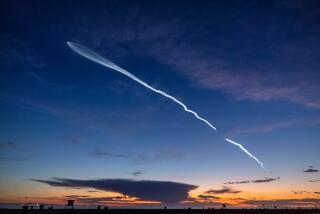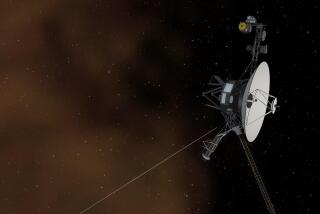Listen to the sounds of interstellar space
Evidence that Voyager 1 had finally entered interstellar space came in the form of two otherworldly noises the spacecraft recorded on its vintage 8-track tape recorder.
At a NASA press conference Thursday, Voyager project scientists played this recording of electron plasma oscillations detected in interstellar space.
The high frequency of the noises, which sound like whistles or shrieks, told scientists that Voyager had entered a region of cold, dense interstellar plasma more than 11 billion miles from Earth.
For all but the most recent year of Voyager’s 36-year journey, the spacecraft traveled through the heliosphere, the comet-shaped region of space dominated by the sun’s solar winds. The solar plasma that fills this region is far hotter and far less dense than the plasma of interstellar space.
“We’re in a truly alien environment. We’ve crossed over,” said Gary Zank, a theoretical physicist at the University of Alabama in Huntsville who works with the Voyager project team.
Voyager 1 was equipped with an instrument designed to measure plasma density when it was launched in 1977. However, after passing by Jupiter decades ago, the device mysteriously quit working.
“The instrument failed in 1980, so the spacecraft is sort of instrument-challenged,” said Don Gurnett, a University of Iowa space physicist and Voyager project scientist. “That’s really one of the major failures we’ve had. There really aren’t that many.”
Gurnett and colleagues used another device on Voyager -- a pair of plasma wave antennas connected to a radio transmitter -- to measure plasma density.
The device only works if a massive flare or coronal mass ejection from the sun sends out a shock wave that reaches Voyager. When this happens, the shock wave causes plasma particles to vibrate.
Voyager’s antennas picked up on two local plasma vibrations and converted them to sound. High frequencies corresponded to high plasma densities.
Based on the recordings and prior research into the heliosphere’s boundary, Gurnett and colleagues determined that Voyager had entered interstellar space around Aug. 25, 2012.







